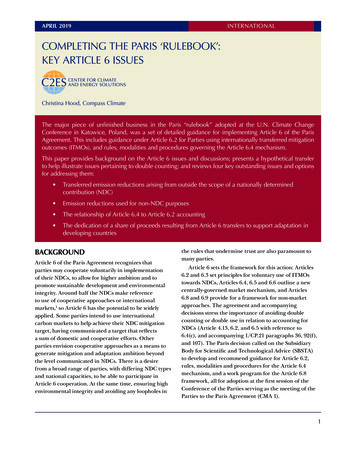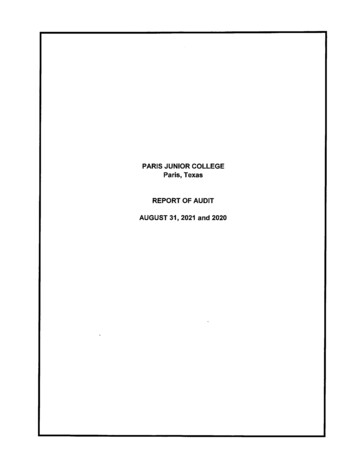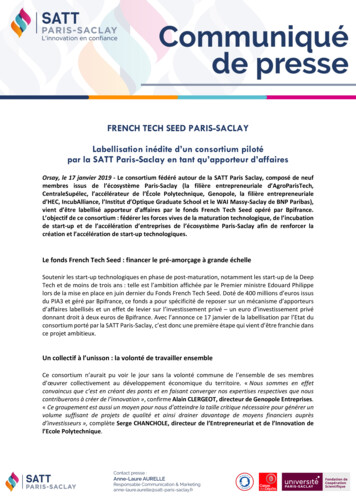
Transcription
APRIL 2019INTERNATIONALCOMPLETING THE PARIS ‘RULEBOOK’:KEY ARTICLE 6 ISSUESChristina Hood, Compass ClimateThe major piece of unfinished business in the Paris “rulebook” adopted at the U.N. Climate ChangeConference in Katowice, Poland, was a set of detailed guidance for implementing Article 6 of the ParisAgreement. This includes guidance under Article 6.2 for Parties using internationally transferred mitigationoutcomes (ITMOs), and rules, modalities and procedures governing the Article 6.4 mechanism.This paper provides background on the Article 6 issues and discussions; presents a hypothetical transferto help illustrate issues pertaining to double counting; and reviews four key outstanding issues and optionsfor addressing them: Transferred emission reductions arising from outside the scope of a nationally determinedcontribution (NDC) Emission reductions used for non-NDC purposes The relationship of Article 6.4 to Article 6.2 accounting The dedication of a share of proceeds resulting from Article 6 transfers to support adaptation indeveloping countriesBACKGROUNDArticle 6 of the Paris Agreement recognizes thatparties may cooperate voluntarily in implementationof their NDCs, to allow for higher ambition and topromote sustainable development and environmentalintegrity. Around half the NDCs make referenceto use of cooperative approaches or internationalmarkets,1 so Article 6 has the potential to be widelyapplied. Some parties intend to use internationalcarbon markets to help achieve their NDC mitigationtarget, having communicated a target that reflectsa sum of domestic and cooperative efforts. Otherparties envision cooperative approaches as a means togenerate mitigation and adaptation ambition beyondthe level communicated in NDCs. There is a desirefrom a broad range of parties, with differing NDC typesand national capacities, to be able to participate inArticle 6 cooperation. At the same time, ensuring highenvironmental integrity and avoiding any loopholes inthe rules that undermine trust are also paramount tomany parties.Article 6 sets the framework for this action: Articles6.2 and 6.3 set principles for voluntary use of ITMOstowards NDCs, Articles 6.4, 6.5 and 6.6 outline a newcentrally-governed market mechanism, and Articles6.8 and 6.9 provide for a framework for non-marketapproaches. The agreement and accompanyingdecisions stress the importance of avoiding doublecounting or double use in relation to accounting forNDCs (Article 4.13, 6.2, and 6.5 with reference to6.4(c), and accompanying 1/CP.21 paragraphs 36, 92(f),and 107). The Paris decision called on the SubsidiaryBody for Scientific and Technological Advice (SBSTA)to develop and recommend guidance for Article 6.2,rules, modalities and procedures for the Article 6.4mechanism, and a work program for the Article 6.8framework, all for adoption at the first session of theConference of the Parties serving as the meeting of theParties to the Paris Agreement (CMA 1).1
COMPLETING THE PARIS ‘RULEBOOK’: KEY ARTICLE 6 ISSUESFIGURE 1: Example of Double Countingconsistency of baselines, and reiterates Paris Agreementlanguage that parties shall “promote environmentalintegrity, transparency, accuracy, completeness,comparability and consistency, and ensure the avoidanceof double counting” in accounting for their NDCs.A related decision on transparency (18/CMA.1paragraph 77(d)) provides general guidance to partiesparticipating in cooperative approaches that involveuse of ITMOs toward an NDC3, or that authorize theuse of mitigation outcomes for international mitigationpurposes other than achievement of their NDC. Thisparagraph requires reporting of annual emissionscovered by the NDC, an adjusted balance reflectingtransfers of ITMOs, and information on how cooperativeapproaches promote sustainable development, ensureenvironmental integrity and transparency, and applyrobust accounting including the avoidance of doublecounting.4Significant progress was made at COP 24/CMA 1in Katowice, with negotiations moving from multipleconceptual options to comprehensive text with a smallnumber of remaining brackets. Convergence was seenin many areas, including in relation to governance,recording of transfers, accounting approaches, and thework program for the Article 6.8 framework. Areas wheremore detailed technical work programs are needed werealso identified, such as the mechanics of correspondingadjustment for non-CO2 and single/multi-year targets,and the details of recording databases. However, a smallnumber of key political and technical issues remainedunresolved. As a result, no substantive decisions onArticle 6 were adopted and SBSTA was requested tocontinue its work, taking into account draft SBSTA andPresidency decision texts, 2 with a view to reporting toCMA 2.Other CMA decisions taken at CMA 1 are relevant toArticle 6. First, the overall guidance for NDC accounting(4/CMA.1) was agreed: Parties will account for NDCimplementation and achievement in their biennialtransparency reports, will provide information onmethodologies used, and where possible, will account inaccordance with methodologies and common metricsassessed by the IPCC and in accordance with decision18/CMA.1. The decision provides more clarity on2Major remaining issues not addressed in this paperinclude issues related to the transition of the CleanDevelopment Mechanism (CDM) (e.g., whether CDMmethodologies, projects and units should be transitionedfrom the Kyoto Protocol for use in the Article 6.4mechanism); technical issues in Article 6.2 accounting(e.g., the “trigger” for applying a correspondingadjustment to avoid double counting, and the mechanicsof corresponding adjustment for single and multi-yeartargets); and technical issues regarding accounting forany trade quantified in terms of metrics other than tonsof carbon dioxide equivalent (tCO2-eq).DOUBLE COUNTING: AN ILLUSTRATIVEEXAMPLETo inform the discussion of accounting-related elementsof Article 6, Figure 1 presents a simple example ofaccounting for transfers arising from a crediting system.In this example, Party H (the “host” party) has an NDCtarget for emissions to be 5 percent below business asusual (BAU). It implements national policies that resultin emission reductions of 5 million tons (Mt) comparedto BAU. It also hosts projects that reduce its inventoryemissions by 6Mt (compared to counterfactual levelsin the absence of the projects). A conservative baselineis used for crediting, so only 4Mt of this reduction isCenter for Climate and Energy Solutions
APRIL 2019FIGURE 2: An Approach to Avoid Double Countingcredited. The 4Mt of credits are used by another party,Party A (the “acquiring” Party), toward its NDC.This example could represent projects in a bilateralcrediting arrangement between Party H and Party Aunder Article 6.2, or projects hosted and authorized byParty H under the central Article 6.4 mechanism. Thedifference between these cases is that credits would mostlikely be issued directly by the host party in the first case,but would be issued by a central registry in the second.In either case, Party H has lower inventory emissionsthan would be the case if the projects had nottaken place. If Party H were to account for its NDCachievement only in terms of its inventory emissions(giving the result that its inventory emissions are 5Mtbelow the target level), it would be benefiting from thesame 4Mt in emission reductions that Party A also countstoward its NDC, i.e. double counting or double use couldarise.Figure 2 shows an approach to avoiding this doublecounting or double use, whereby a correspondingadjustment is made by Party A and Party H. After thecorresponding adjustment for the 4Mt, Party H stilloverachieves its NDC target, but by 1Mt rather than 5Mt.TRANSFERS FROM OUTSIDE THE SCOPEOF AN NDC TARGETNDCs reflect a major broadening of the sectoral coverageof mitigation goals compared to the pre-2020 period,with the majority of parties presenting economy-wideCenter for Climate and Energy Solutionsabsolute, BAU, intensity or peaking year greenhouse gastargets in their NDCs. Nonetheless, many NDC targetscover a smaller set of sectors and/or gases than theparties’ National Greenhouse Gas Inventories, in whichcase the NDC targets are not fully economy-wide.5 TheUNFCCC’s summary of NDCs finds that while nearlyall NDCs address the energy sector, only around threequarters cover transport, waste, and LULUCF (land use,land use change, and forestry). Similarly, it finds thatnearly all NDCs address carbon dioxide emissions, but anumber do not encompass methane, nitrous oxide andthe other gases.6 In some cases, parties may have leftsectors or gases out of their NDC where they have poorinformation, and they may wish to use the opportunityof hosting projects to build capacity in these sectors. It istherefore possible that transferred emission reductionscould originate from sectors or gases not included ina host party’s NDC mitigation target but covered by itsnational inventory.7From a technical standpoint, avoiding doublecounting or double use in the case of transferredemission reductions arising from outside the NDC targetsectors or gases is simple, because the emission reductionis only contributing to achievement of the acquiringparty’s NDC mitigation target and not the host’s NDCtarget. As such, one option for addressing such transfersis that no corresponding adjustment of the type shown inFigure 2 would be required for the host party.However, this approach could create an incentivefor the host to not expand the coverage of its NDC in3
COMPLETING THE PARIS ‘RULEBOOK’: KEY ARTICLE 6 ISSUESFIGURE 3: Incentive for Host Party to Not Expand Coverage of its NDC in Future Periodsfuture periods (Figure 3). As long as the project remainsoutside the NDC, the inventory emissions in that sector(outside the NDC) would be reduced. If the NDCcoverage was expanded, the need to make an accountingadjustment might be perceived as a disadvantage by thehost party, as the transferred reduction could not becounted toward its NDC. There could also be concernsabout the environmental integrity of credits from sectorsoutside the NDC: As these do not “count” in terms oftheir NDC, the host party may have less incentive toensure high quality. The “no adjustment” accountingoption is therefore regarded by some as contrary tothe overall thrust of the Paris Agreement’s mitigationprovisions which emphasize progression and highestpossible ambition (e.g. Article 4.3), and with Article6.1 which recognizes cooperation “to allow for higherambition.”Accounting options which place more emphasison incentives for progression of NDC coverage overtime include: prohibiting transfers from emissionreductions outside the NDC target; placing quantitylimits on transfers from outside the NDC; requiring acorresponding adjustment to the host Party’s NDC evenfor transfers arising outside the NDC; or requiring thehost party to make corresponding adjustments onlyfrom a certain date such as 2031 or the Party’s next NDCperiod.One detail that needs further technical considerationis the alignment between project crediting periodsand NDC accounting: if crediting periods are longerthan NDC periods, projects may transition from being“outside” to “inside” the NDC.8An alternative concept of “outside” an NDC has arisenin the Article 6 negotiations, relating to going beyondthe actions required to meet the NDC target, ratherthan referring to coverage of sectors or gases. In thisviewpoint, an emissions-reduction activity that is notimplemented by the host government for the purpose ofachieving the NDC could be seen as “additional” to theNDC. This could for example apply to activities in sectorsBox 1: Options for Transfers from Outside the Scope of an NDC Target4 No adjustment required by host party for transfers from outside its NDC target scope Time limit before host-party adjustment required (e.g. 2031) Quantity limits on use of transfers from outside NDC Transfers not allowed from outside NDC Host party must adjust NDC emissions balance for all transfers even those from outside NDCCenter for Climate and Energy Solutions
APRIL 2019Box 2: Options for Use of Emission Reductions for Non-NDC purposesArticle 6.2: Explicit host-party authorization for use of Article 6.2 ITMOs for non-NDC purposes Further transparency reporting of authorized non-NDC use Application of Article 6.2 guidance to authorized non-NDC use of ITMOsArticle 6.4: Host party adjustment (or no host party adjustment) for non-NDC use of emission reducionswhere the government has no NDC policies, Article 6.4projects that are implemented and owned by projectparticipants, or additional ambition beyond the NDCtarget. This has a linkage to the concept of additionality,i.e. ensuring that crediting projects make emissionreductions beyond what would otherwise have occurred.Some parties have proposed that host parties should nothave to make corresponding adjustments for reductionsthat go beyond the NDC, but other parties note that suchprojects can still reduce inventory emissions comparedto what they would have otherwise been, and therebycontribute to the host Party’s NDC (c.f. Figure 1), raisingthe possibility that the absence of an adjustment couldlead to double use of emission reductions.EMISSION REDUCTIONS USED FOR NONNDC PURPOSESEmission reductions could potentially be used, ortransferred and used, for purposes other than towardachievement of an NDC. Examples include voluntarycancellation of credits to enhance mitigation effort, anduse towards mitigation obligations outside the UNFCCC,such as in the International Civil Aviation Organization(ICAO)’s Carbon Offsetting and Reduction Schemefor International Aviation (CORSIA) scheme that willrequire airlines to offset emissions growth from 2021onwards. Avoiding double counting between NDCsand the CORSIA system is particularly pertinent due toCORSIA’s very large potential demand of 1.6-3.7gigatonsbetween 2021 and 2035.9In March 2019, the ICAO Council approved UnitEligibility Criteria for CORSIA and established atechnical advisory board that will assess the eligibilityof programs that are to provide offsets meeting thosecriteria.10 The criteria require that credits be countedCenter for Climate and Energy Solutionsonly once toward a mitigation obligation, and thatmeasures be in place to avoid double claiming betweenan airline and the host country of the emissionsreduction. Avoiding double counting between NDCs andCORSIA also implies action on the UNFCCC side: assketched in the example of Figure 1, emission reductionsfrom a crediting project could contribute to a lowernational inventory and hence toward NDC achievement.Transparency decision 18/CMA.1 paragraph 77(d)references the possibility of non-NDC use of ITMOs.This decision requires that a party report information ontransfers if it “authorizes the use of mitigation outcomesfor international mitigation purposes other thanachievement of its NDC.” A related issue in the Article6.2 discussions is whether the Article 6.2 accountingguidance should apply to such transfers.11 Otherissues include whether information reported via thetransparency framework should include more detail suchas quantities authorized for non-NDC use and the natureof their use. There is convergence in the negotiationsthat units from Article 6.4 activities could be used fornon-NDC purposes, but there remains disagreement onwhether an accounting adjustment similar to that shownin Figure 2 should be made by the host Party to avoiddouble use of emission reductions.RELATIONSHIP OF ARTICLE 6.4 TOARTICLE 6.2 ACCOUNTINGA conceptual question remaining in Article 6 discussionsis the relationship of units generated by the Article6.4 mechanism (A6.4ERs) to the ITMOs referenced inArticle 6.2, and whether a single accounting processshould address both.The Paris Agreement requires that parties avoid5
COMPLETING THE PARIS ‘RULEBOOK’: KEY ARTICLE 6 ISSUESBox 3: Options for the Relationship of Article 6.4 to Article 6.2 Accounting Use Article 6.2 corresponding adjustment mechanisms to avoid double counting in relation to Article 6.4. Develop separate accounting for Article 6.4 that avoids use of emission reductions by more than one party,consistent with Article 6.5.double counting in the use of ITMOs towards NDCsunder Article 6.2, and avoid double use of Article 6.4emission reductions for achievement of NDCs (Article6.5).One option under consideration is to treat A6.4ERsthe same way as ITMOs and use the mechanisms ofcorresponding adjustment developed for Article 6.2(similar to that shown in Figure 2) to avoid doublecounting and/or double use of all transfers using a singleprocess.As A6.4ERs would be issued from a central registryfor the Article 6.4 mechanism, rather than by the hostparty itself, another proposed option would require nocorresponding adjustment when credits are transferredfrom the registry (being “additional” to the NDC fromthis perspective), but would require an adjustment forany subsequent trades.The example shown in Figure 1 suggests that to theextent that projects producing A6.4ERs deliver lowerinventory emissions than otherwise would have been thecase, they may contribute to the host Party achievingits NDC target (depending on the sector, gas, and timeperiod in which the project is operating). This raises theprospect that in the absence of an adjustment, the hostand another Party acquiring the A6.4ERs might bothcount the emission reductions.SHARE OF PROCEEDS FOR ADAPTATIONA percentage of certified emission reductions (CERs)issued under the Kyoto Protocol’s Clean DevelopmentMechanism are set aside to cover administrative costsof the mechanism, and to provide funding for theAdaptation Fund. As of June 30, 2018, monetization ofthe levied CERs has provided US 199.4 million of thefund’s cumulative US 753.3 million in receipts.126Decision 1/CMP.8 extended the share of proceedsunder the Kyoto Protocol to cover all its marketmechanisms, including joint implementation (JI)activities between developed countries.13 Under Article6.6 of the Paris Agreement, a share of proceeds fromactivities under the Article 6.4 mechanism wouldsimilarly be used to cover expenses and help particularlyvulnerable developing countries meet the costs ofadaptation.Although the Paris Agreement makes no mention ofan equivalent levy on Article 6.2 transfers, some partiesare proposing one, so that Article 6.2 crediting systemsare not advantaged relative to the Article 6.4 mechanism,and as an additional revenue stream to the AdaptationFund. The range of options proposed is summarized inthe box below. Other parties oppose these proposals asunauthorized under the agreement and as a disincentiveto transfers. They also note a potential legal impediment,in that an amendment to the Paris Agreement ratherthan a CMA decision might be required to implementa share of proceeds (c.f. the Doha Amendmentimplementing a share of proceeds for JI).Some activities under Article 6.2 could be creditingsystems similar to the Article 6.4 mechanism. However,Article 6.2 would also cover transfers resulting frominternational linkages between emissions tradingsystems. If two domestic emissions trading systemslink, levying a share of proceeds only on internationaltransfers would distort trading by imposing a cost ononly some allowances within the system, creating adisincentive to link and affecting domestic policy.In the absence of an explicit levy on Article 6.2activities, participating parties could be asked toreport on how mechanism revenue is used to supportdeveloping countries’ adaptation needs.Center for Climate and Energy Solutions
APRIL 2019Box 4: Options to Share Proceeds in Relation to Article 6.2Subject 6.2 activities: No share of proceeds for any Article 6.2 activities Share of proceeds only for crediting systems/systems similar to Article 6.4 Share of proceeds for all Article 6.2 activities or all acquisition of ITMOsStructure and timing of levy: Share of proceeds levied at issuance/first transfer Share of proceeds levied at every trade Share of proceeds levied at issuance or at use toward NDCsAlternatives to share of proceeds: Reporting on use of mechanism revenues to support developing countries’ adaptation needsCenter for Climate and Energy Solutions7
COMPLETING THE PARIS ‘RULEBOOK’: KEY ARTICLE 6 les/resource/94 IETA%20input%20to%20TD final.pdf2The decision notes that sections III.A, III.B and III.C of the Presidency text do not reflect consensus and arewithout prejudice to the views of parties and consideration by the CMA.3Even in the absence of agreed guidance under Article 6.2 transfers can proceed, but participating parties wouldstill need to meet the principles of Article 6.1, 6.2 and 6.3 in their use of ITMOs toward NDCs. Paragraph 77(d) provides aprocess for parties to report relevant information.4Decision 18/CMA.1 (in relation to Article 6) notes that the information referred to in paragraph 77(d) iswithout prejudice to the outcomes of discussions on Article 6 matters.5The transparency decision of -/CMA.1 requires all parties’ national inventories to cover energy, industrialprocesses and product use, agriculture, LULUCF and waste, according to IPCC guidelines. Most parties will report onseven gases (carbon dioxide (CO2), methane (CH4), (nitrous oxide (N2O), hydrofluorocarbons (HFCs), perfluorocarbons(PFCs), sulphur hexafluoride (SF6) and nitrogen trifluoride (NF3)), but those developing countries that need flexibility inlight of their capacities have flexibility to report on at least three gases (CO2, CH4 and N2O) as well as any of the additionalfour that are included in the Party’s NDC or are covered by an activity under Article 6. As such, any sectors or gases relevantto an Article 6 activity will be covered by the host Party’s national inventory.6Synthesis report on the aggregate effect of the intended nationally determined contributions, Available at:http://unfccc.int/focus/indc portal/items/9240.php.7For NDC targets expressed for a single year only, emission reductions can also be “outside” the NDC in terms oftime. In the SBSTA negotiations, this is being addressed through a separate stream of work that relates to accounting forsingle- and multi-year targets.8For comparison, standard crediting periods in the Clean Development mechanism are up to 21 years (7 years,with two possible renewals) and can be even longer for afforestation in/media/dokumente/sonstige downloads/CTIWorkshop 2017/5 Healy 170623 CORSIA CTI ges/CORSIA-implementation-on-course.aspx11 In this case the mitigation outcomes would not necessarily be transferred internationally, but an adjustmentwould still be needed to avoid double counting or double use.12 Report of the Adaptation Fund Board, 3 October 2018, FCCC/KP/CMP/2018/4, https://unfccc.int/sites/default/files/resource/4e 1.pdf13This is yet to be implemented, as 1/CMP.8 the Doha Amendment to the Kyoto Protocol has not yet entered intoforce.The Center for Climate and Energy Solutions (C2ES) is an independent,nonpartisan, nonprofit organization working to forge practical solutions toclimate change. We advance strong policy and action to reduce greenhouse gasemissions, promote clean energy, and strengthen resilience to climate impacts.3100 CLARENDON BLVD. SUITE 800 ARLINGTON, VA 22201 703-516-4146C2ES.ORG
Presidency decision texts,2 with a view to reporting to CMA 2. Other CMA decisions taken at CMA 1 are relevant to Article 6. First, the overall guidance for NDC accounting (4/CMA.1) was agreed: Parties will account for NDC implementation and achievement in their biennial transparency reports, will provide information on











